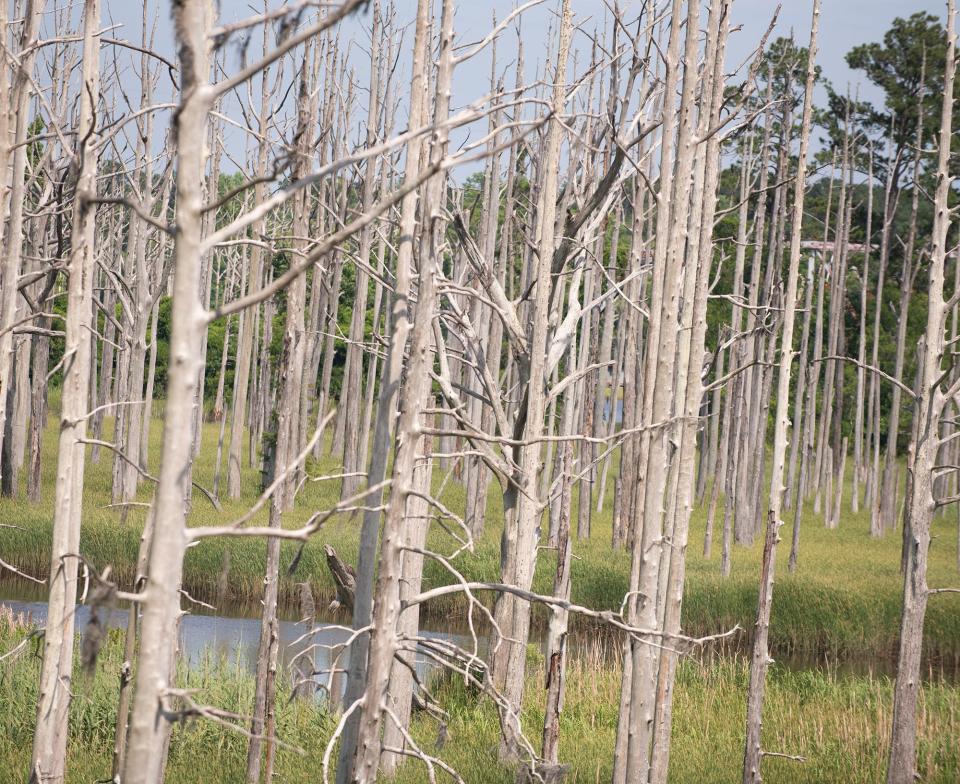Ancient NC trees have survived thousands of years. Will they weather climate change?
Under a thick green canopy in swampy waters where mosquitoes sing and the humidity is cut with a knife, some of the most ancient organisms on Earth continue to hold court roughly 40 miles north of Wilmington.
Bald cypress trees older than the Roman Empire dot these swamplands of the Black River that meanders through Sampson, Bladen and Pender counties.
MORE Study says climate change could impact the rapid growth along the NC, SC coasts
Gnarled and many with hollow bases, some with cavities big enough to easily swallow children, the cypresses have survived droughts, fires, floods, disease and a massive hurricane 600 years ago that cleaved off many of their tops — potentially one reason they were saved from logging, unlike many of their brethren.
“Through their rings these trees tell those stories,” said Nathan Burmester, coastal manager for The Nature Conservancy, as he kayaked around cypress root “knees” that can become waterborne obstacles during periods of prolonged drought.
Scientists say longer and more severe droughts are one of the expected changes North Carolina will see in coming decades due to climate change.
Warmer temperatures could also mean new varieties of pests and diseases moving in from the tropics. Rising sea levels, allowing pulses of salt water to push farther inland into interconnected waterways and swamps, are another threat. Already, trees closer to the coast are turning into “ghost forests” as increasing salinity levels turn brackish waters too salty. Then there are hurricanes, which are expected to be larger and more powerful as they are fueled by the changing climate.
TALKING TREES What ancient trees from New Bern to Wilmington are telling us about future flooding events
Pointing to the gnarled trees as he stood on a mid-stream sandy rise, Burmester said one of the cypresses had been found to be more than 2,600 years old, but scientists believe even older trees are scattered throughout the river’s Three Sisters Swamp.
“That makes them the fifth-oldest tree species and the oldest wetland tree species on the planet,” he said.

Running his hand over one of the grizzled trunks, Burmester said the ancient stands aren’t believed to be under urgent threat from climate crisis today. But climate risks, especially to the river’s water quality, remain.
Although on land protected by the conservancy, development and industrial farms are encroaching. Biomass farming, where forests are turned into wood chips to fuel European power plants — ironically because they're seen as a "greener" alternative to using fossil fuels — is also a growing industry in Eastern North Carolina.
MORE Classroom confidential: Why science teaching got controversial in NC this year
As his shoe squished into thick swamp muck, Burmester said he was hopeful that a mix of conservation and cleaner energy measures could save these survivors for future generations.
“They’ve seen a lot already, and hopefully they’ve got centuries to see a lot more,” he said.
Reporter Gareth McGrath can be reached at GMcGrath@Gannett.com or @GarethMcGrathSN on Twitter. This story was produced with financial support from 1Earth Fund and the Prentice Foundation. The USA TODAY Network maintains full editorial control of the work.
This article originally appeared on Wilmington StarNews: Ancient NC bald cypress trees near Wilmington face climate crisis

